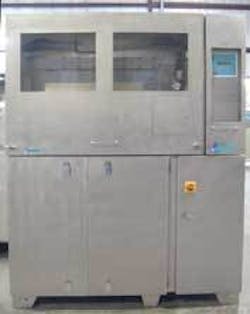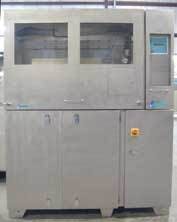On-Site Disinfection System offers Automated Control
New systems offering on-site, on-demand generation of dilute hypochlorite, coupled with automated chlorine dosing and remote monitoring, can be operated for days or even weeks without operator intervention.
On-site generation equipment can be purchased by any facility to generate its own chlorine without having to transport hazardous chemicals. The feedstocks to the equipment are salt and water, which form a chlorine-based liquid disinfectant when electrolyzed. Like other forms of chlorine, chlorine generated on site is effective against common microorganisms and also leaves a chlorine residual. On-site generation has become an established disinfection technology with over 4,000 installations across the country from a variety of manufacturers.
The very design of on-site generation offers labor savings by eliminating shelf life and degradation issues, particularly important for operators with a less technical skill level. Generating the hypochlorite solution on demand means that the operator does not have to compensate for diminishing concentrations or adjust mixing and dilution ratios, as with delivered bleach. The disinfectant is also generated at a safe concentration of < 1% free available chlorine, just below the threshold for hazardous materials. Due to this low concentration, the solution is far less corrosive than 12.5% bleach.
Systems from the Miox Corp. offer automatic chlorine dosing controlled by a 4-20 mA input from chlorine residual monitors. This set-up guarantees that sufficient chlorine residuals are retained in the distribution system, even with fluctuations in chlorine demand. In addition, there is no longer a need to manually adjust dosage levels to accommodate fluctuations in chlorine concentration.
Guaranteeing the proper residual ensures compliance with chlorine standards and drastically reduces coliform violations. As regulatory violations decrease, follow-up monitoring, public notifications, and their associated expense are also reduced. Automation of any sort also reduces required operational hours, which would again permit more time to perform other operational tasks.
A final option for automation is the integration of internet monitoring software. This feature is newly available on MIOX equipment and allows remote access and visibility into system operation. The monitoring can be set up to notify the water plant operator, MIOX customer service, or a secondary service provider whenever the equipment goes into fault, guaranteeing a more rapid response.
Many of the operational fixes are simple tasks that can be performed more easily with tailored instructions from a service provider, even when operators on site are not highly trained.
On-site generation systems with automated chlorine dosing and internet monitoring can be run with little or no operator intervention for days and even weeks. For remote sites, operator visits to treatment stations would be reduced, with a corresponding reduction in expense and labor hours.
Should the water supply become inadequate for drinking, MIOX on-site generation systems are designed to alert the operator and shut off provision of water. With sufficient storage tank volume, properly treated water will still be available for days and sometimes even weeks before operator intervention is required.
Equipment capacities range from 1 to 1000 pounds of free available chlorine (FAC) per unit per day. With almost unlimited modularity, MIOX equipment is suitable for any size community. For more information visit the company’s website at www.miox.com

